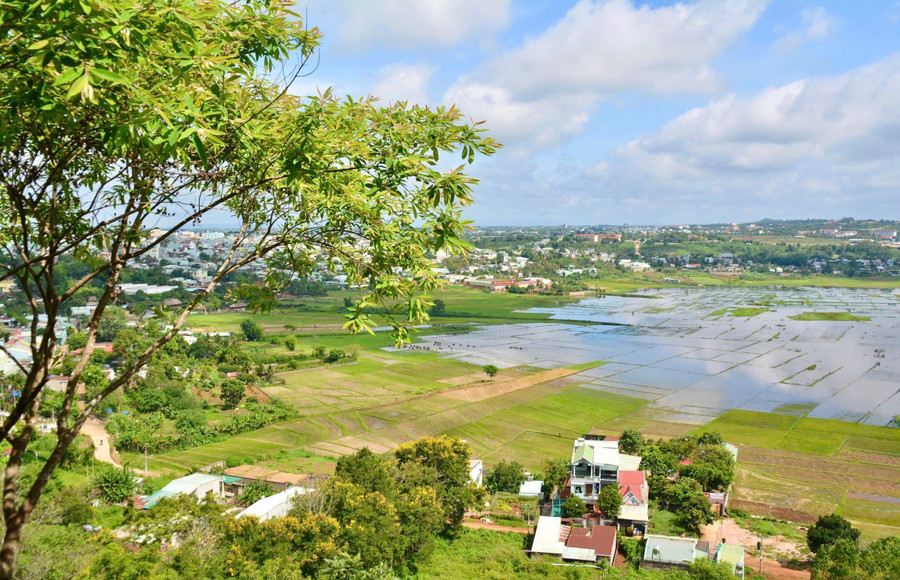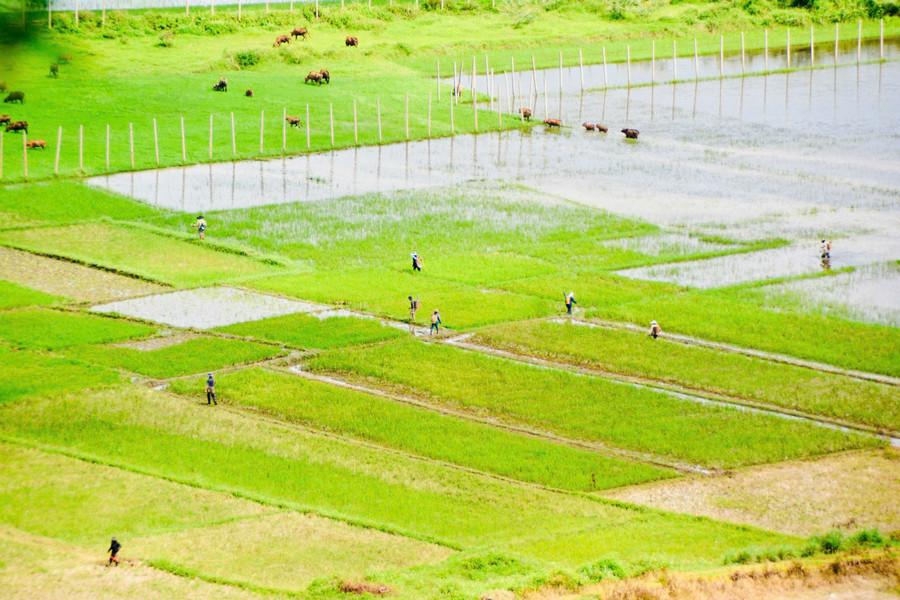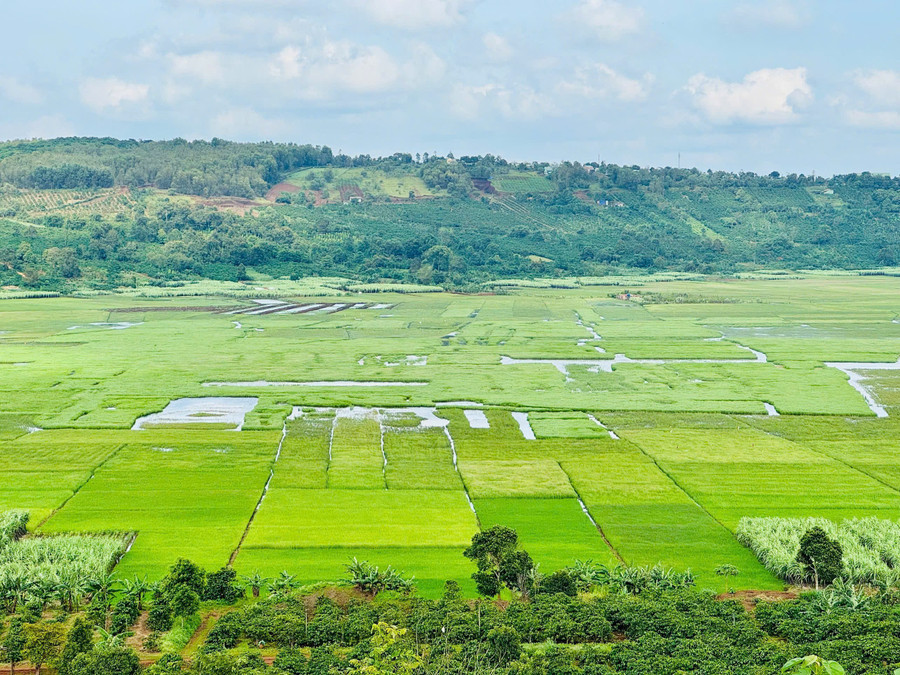Land of the Craters
Gia Lai is known by scientists as the “land of volcanic craters” with more than 30 volcanic craters existing in the form of ancient yin and ancient yang. Among them, ancient yin volcanoes are now valleys forming fertile fields and vast lakes with waves. The geological formation of the extinct volcano for millions of years has drawn the shape of a wide and long valley, especially on days when there is water flowing to the fields.
Of course, the flood season does not follow the rules of the four seasons: spring-summer-autumn-winter or be divided according to the characteristics of the two rainy-sunny seasons of the highlands. Because the flood season often comes like an impromptu lyrical melody, not on the right day, not on the right time, sometimes immense, abundant, sometimes just enough to embellish the landscape of the basalt land, marking the characteristic features of the urban landscape that not every place has.

Pleiku Plateau currently has about 11 negative volcanic craters, forming lush green basins, adjacent to the hillsides. The depressions retain water, creating natural lakes that are both gentle and majestic and are rare geological heritages of the mountain town. If Pleiku ward is taken as the center, the West is Ia Nung valley nestled along Pham Van Dong street; the East valley is on Ngo Thi Nham street running in an arc extending to Ia Sol bridge, Cach Mang Thang Tam street; the South valley is on Le Thanh Ton street (adjacent to Truong Sa street) in Hoi Phu and Dien Hong wards; the valley in Nhao 1 village (Gao commune); the valley in Ia Tonh field (Thong Nhat ward)... These valleys both have geological and ecological value and are closely associated with the lives of residents.
Lost in the fields
Stopping the car by the small alley across Ngo Thi Nham street, we carried our shoes and walked around, following the grass. The grass was wet, muddy, and slippery. Under our feet, the motorbike tire tracks looked like scribbles. In front, there were a few young men walking and chatting happily, fishing rods in their hands. Starting a conversation, one of them quickly replied: "While the water is coming back, we invited each other to go fishing to catch some good fish." Looking into the distance, we could see a figure casting a line on the edge of the rice field.
It can be seen that the rich fertility of the fields has helped the local people's rice plants to be green and lush all season long. Again, the Jrai and Bahnar people in the past were used to cultivating upland rice, so before the technology of building embankments, this basin was only used to grow corn, potatoes or as a grazing ground for cattle.

In the early 20th century, Kinh families from Binh Dinh came to settle down and brought with them their experience in wet rice cultivation. The fields were divided into small plots, the fields were built high and straight, preventing water from flowing out. Rain after rain, the water gradually filled up, until the whole basin was covered with young rice. During the flood season, when the sunlight poured down, the fields sparkled like silver.
In the dry season, the valley is covered with green young rice, the edges of the fields draw soft, winding lines following the terrain. But when the rainy season comes, water from the mountainsides and fields pours down, filling each field, turning the entire valley into a giant mirror reflecting the clouds and sky. On the fields that stretch out like a green carpet, the silhouettes of women wearing conical hats, diligently and diligently working in the rice fields, become gentle highlights in the picture of the crop season. The fields near water sources or with water veins are prepared first and become the place to store water for the next fields.
The flood season in the Pleiku plateau not only brings immense waves of water on ancient volcanic craters, but also awakens the industrious life of young rice fields. The rice fields that were only seen with stubble yesterday have now become seas of water, welcoming a season of fish going upstream to lay eggs: anchovies, crucian carp, and long tong fish…
Mr. Til (Op village, Pleiku ward) said: It has been raining for the past few days, knowing that fish are coming back, he invited some brothers in the village to go fishing. On lucky days, he can earn nearly 10kg of fish, bring them to the market to sell, and the family has a little extra money to cover their living expenses. Crucian carp are available here all year round, but the flood season is the most abundant. The fish live in a natural environment so their meat is sweet, firm and fragrant, and each fish has a round belly full of eggs. The flood season passes gently and peacefully with many residents living in the heart of the city. The villages living next to the valley have for hundreds of years relied on the craters as a way of making a living.
Meeting point in the heart of the city
Moving over time, the ancient volcanic valleys in the Gia Lai plateau are not only associated with agriculture , but also become an advantage for many eco-cafes. The basin terrain and gentle slopes of the valley during the flood season have become "resources" for cafes to exploit the landscape. Looking down from above, the valleys are like giant mirrors capturing the clouds, reflecting each gust of wind and each afternoon rain. That is when the landscape changes color the fastest and is also the time when many cafes choose the space to create a "visual rendezvous" for customers.

The beauty of these cafes is that they do not “compete” with the landscape, but let the terrain guide the emotions. The flood season brings an interesting experience, both admiring the vast waves of the lake surface, embracing the view of the gentle green hills, and breathing the fresh air with the blue sky of the highlands.
Some cafes that can be mentioned are: Hani Kafe & Kitchen, Chill Factory Coffee, Cafe Ngay Binh Yen (To Vinh Dien street, Pleiku ward), Zin's Farm (Nhao 1 village, Gao commune)... All cafes let nature guide the emotions, letting coffee be just an excuse for a sitting and watching the valley change color.
The flood season in the Gia Lai plateau is a rare intersection of geology, climate, soil and culture. It is a gift from nature that both feeds the residents and outlines a unique tourism product for the locality. If properly planned and combined with ecosystem conservation, service experience enhancement and agricultural identity preservation, the negative crater valleys can become attractive tourist destinations.
A journey to explore the valley during the flood season will be far different from the usual “go-take-photo-return” type of tourism. If we incorporate the million-year story of the volcano, the breath of the soil and the seasonal rhythm of the indigenous people into each trip, the valley during the flood season promises to be an attractive journey for those who are passionate about exploring and learning when going up to the highlands.
Source: https://baogialai.com.vn/cao-nguyen-mua-nuoc-noi-post566426.html



![[Photo] Editor-in-Chief of Nhan Dan Newspaper Le Quoc Minh received the working delegation of Pasaxon Newspaper](https://vphoto.vietnam.vn/thumb/1200x675/vietnam/resource/IMAGE/2025/9/23/da79369d8d2849318c3fe8e792f4ce16)

![[Photo] Prime Minister Pham Minh Chinh chairs the 14th meeting of the Steering Committee on IUU](https://vphoto.vietnam.vn/thumb/1200x675/vietnam/resource/IMAGE/2025/9/23/a5244e94b6dd49b3b52bbb92201c6986)
































































































Comment (0)